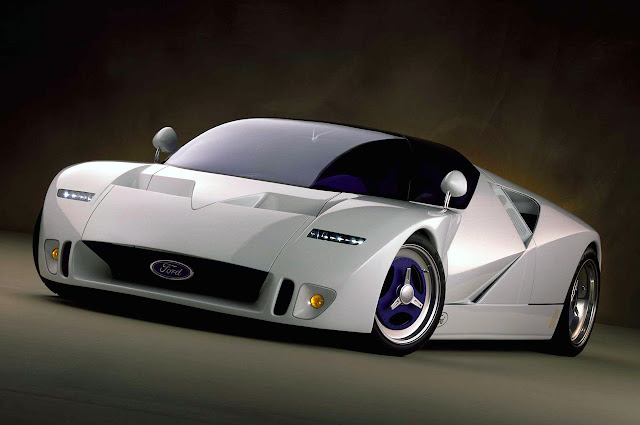The Ford GT90 was and still is one of the coolest Supercar concepts ever to come out of the USA. The car looks like it could have just been released, not that it is 15 years old. The vehicle was innovative with its V12 mid-engine, quad turbos, and all-carbon fiber body. Check out the Press Release from RM Sotheby’s Auctions Below for more on this one-of-a-kind car that went up for auction in 2010.
The Ford GT90 is powered by an Est. 720 bhp, 6.0-liter quad-turbocharged mid-engine V12, five-speed manual gearbox, four-wheel independent suspension, and four-wheel ventilated disc brakes. Wheelbase: 116″The one-off GT90 Concept Car, labeled immediately as “the world’s mightiest supercar” by Ford Motor Company on December 6, 1994, was the spiritual successor to the Ford GT40, the product of a colossal feud in the early 1960s between the Blue Oval from Dearborn and the Prancing Horse of Northern Italy. The Ford GT90 draws from the design cues of its heritage and pays homage to the famed Le Mans-winning Ford GT40s of the 1960s, which were created after Ford failed to buy out Ferrari. GT40 HeritageThe failed acquisition of Ferrari only strengthened Henry Ford II’s resolve to beat Ferrari, and he, therefore, decided to take on the Commendatore head-on in international sports car racing.
Trying To Recapture That ’60s Magic
There was very little interest in this form of racing in America at the time, but Ford was prepared to gamble that European wins, Le Mans, in particular, would capture the country’s imagination. He was right after the Ferrari debacle, Henry Ford II declared that he wanted to win Le Mans in 1966, and Ford’s Lee Iacocca and Leo Beebe were given the job of forming Ford Advanced Vehicles. Instructed by Henry Ford II to spend whatever money necessary to develop a racing program that would beat Ferrari in the most public of ways, the team went to work. Ford’s idea was to develop a car that could be built around the 1963 Indianapolis 4.2-liter pushrod engine. The mid-engined coupe that the company had in mind was to be the very cutting edge of modern GT car design with careful attention paid to aerodynamics. Ford realized that many of their plans were echoed in the Lola GT, designed and built by Eric Broadly at his workshop at Bromley in England. Broadly, too, he had seen the potential of the Ford V8 as a GT racing engine and incorporated a stock 260 cubic inch version in his car, first exhibited at the London Racing Car Show in January 1963. As it happened, the Lola GT was 40 inches high. The Ford GT would also be this height, and it is for this reason that the car was christened the GT40.
The first two prototype Ford GT40s were launched in April 1964, and the GT40’s first race was the 1,000 kilometer at the Nürburgring on May 31. Phil Hill qualified the blue and white coupe second to John Surtees’s Ferrari 275P, and although the car retired with a broken suspension bracket, the GT40 had shown its potential. In 1965, when the project was handed over to the Shelby-American team of Cobra fame, a total of ten cars had been built. By the end of February 1965, a number of significant changes had been made to the car under the direction of Carroll Shelby, his chief engineer Phil Remington, and Ken Miles, Shelby’s test driver. The 4.2-liter dry sump Indianapolis engine was replaced with the famous wet sump 4.7-liter, 289 cubic inch V8 that powered Shelby’s Cobras and developed 385 brake horsepower. The first race the re-worked car entered was the 2,000-kilometer Daytona Continental Race on February 28, 1965. The car, driven by Lloyd Ruby and Ken Miles, won the race with Bob Bondurant and Richie Ginther in a second car finishing third. Suddenly, the GT40 was on the map and a force to be reckoned with.
With the GT40 now fully developed, Roy Lunn was given the job of overseeing the production of a Mark II version of the car. Work on two new cars began in the spring of 1965 at a new Ford racing subsidiary, Kar Kraft, in Detroit. The GT40 Mark II was fitted with Ford’s mighty 7.0-liter V8. The engine had tremendous torque and a wide power band and had been very successful in racing in other formats. The Mark IIs were immediately quick, finishing first, second, and third in the 1966 Daytona 24-Hour race; this was followed by victory at the 12 Hours of Sebring and the famous clean sweep at Le Mans, where Ford GT40s once again crossed the line first, second, and third. Ford’s gamble had paid off, and the GT40 dominated sports car racing, as intended, making it one of the most successful road/competition cars ever built.
1995 Ford GT90 Concept
Development of the Ford GT90 At a development cost in the neighborhood of $3 million, the Ford GT90 was undoubtedly worthy of pulling styling cues from the original Ford GT, and although it was never meant for production, it was built according to a Ford press release as a “test bed for technology, engineering and design concepts, and driver-oriented features that eventually may be used in Ford production vehicles.” Officially unveiled to the public in January 1995 at the Detroit Auto Show, the Ford GT90 is finished in bright white with a bright blue and carbon fiber interior. It features a mid-engine quad-turbocharged V12 that produces an estimated 720 horsepower and 660 pound-feet of torque. As a result, it had a claimed top speed of 253 mph, which even by today’s standards would make it one of the fastest production cars in the world – faster even than a McLaren F1, which was widely considered the world’s preeminent supercar at the time. Built by a small specialized group over at Ford SVT in just over six months time, the concept’s development timeline was very tight and therefore borrowed components from other vehicles. The team mainly borrowed parts from another supercar that was also way ahead of its time, the Jaguar XJ220.

The engine, which was a 48-valve six-liter V12, had to be combined together with four Garrett Systems T2 turbochargers in order to reach its estimated 720 horsepower and was based on the Ford Modular engine. Created by using parts of two Lincoln V8 engines, engineers removed the last pair of cylinders from the rear of one engine and the first pair of cylinders from the front of the other engine. The cut-down engines were then welded together, with the final result being a 90-degree V12, which utilized a 90.2 mm bore and a 77.3 mm stroke to achieve maximum power. The Ford GT90 features the FFD-Ricardo five-speed manual gearbox found on the XJ220 and, considering the torque load that it is designed to handle, is noted as having a relatively light shift quality. Also borrowed from the XJ220 comes the all-around double wishbone suspension that was designed to enable the car to handle well at top speeds. Using Ford’s new “Edge” design philosophy, the car incorporated advanced technology with a mixture of flat planes, angles, glass, and triangular shapes that seemingly collided. The Ford GT90 was the first car created using this new styling directive from Ford, which went on to be responsible for the creation of other Ford products like the Ka and Cougar. The effect is most impressive and a wonderfully executed stylistic throwback to its GT40 predecessor, which at once stays true to its heritage but acknowledges the advances in modern design.
Taken directly from race car technology, the Ford GT90 body panels are molded out of carbon fiber while the chassis is formed out of a honey-comb sectioned aluminum monocoque. The Ford GT90 is a test bed of advanced technology and design. It sports a tinted, laminated glass bubble over the cockpit and a spoiler that rises off the rear deck at high speeds. According to Ford, it has a “design that tightly enclosed its mechanicals with no wasted space; high tech lighting and blind-spot detection systems; and tiles like those on the space shuttle to shield the V12’s exhaust outlets.”The interior of the car is easily accessed by pushing on a small yellow panel located on the B-pillar that allows the door to swing open. Amazingly for a supercar, it is relatively easy to climb into the cockpit, as the door sill is low and narrow, and the glass, which arcs well into the roof, is fixed to the door. Reminiscent of an airplane cockpit, the interior is finished in bright blue suede and leather, a carbon fiber center console, and custom blue-lit gauges. An abundance of brushed and polished aluminum adorns the interior, from the open shift gate and linkage to the controls on the center console right down to the key for the car.
Ford’s engineers included a few other options that were designed for use on the show circuit; the tires were specially made with “GT90” carved directly into the tread, and the doors, as well as all of the lights, both inside and out, could easily be opened or turned on via a remote control. After its unveiling in Detroit, the Ford GT90 made its rounds on the Auto Show Circuit in 1995, traveling around the world to Frankfurt and as far away as Tokyo. With few other showings in between, the car was recently shipped over to Europe to be on display in the Ford of Europe 2008 exhibit at the Goodwood Festival of Speed. After returning home, the car was shipped to Alabama, where it was on display as part of the Mustang 45th Anniversary Celebration.
Photos Courtesy of RM Sotheby’s





















